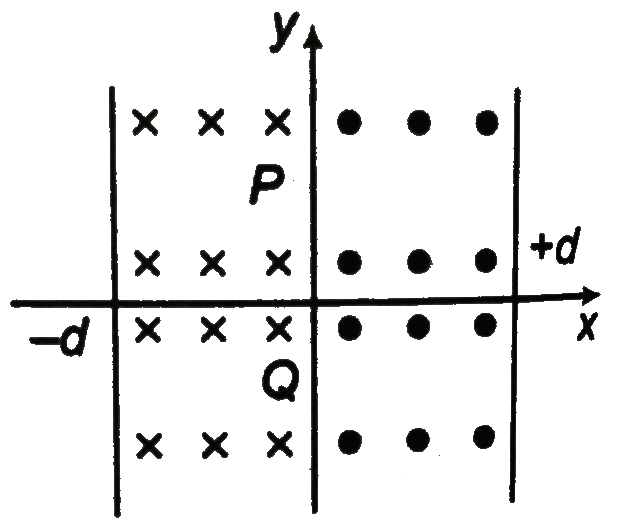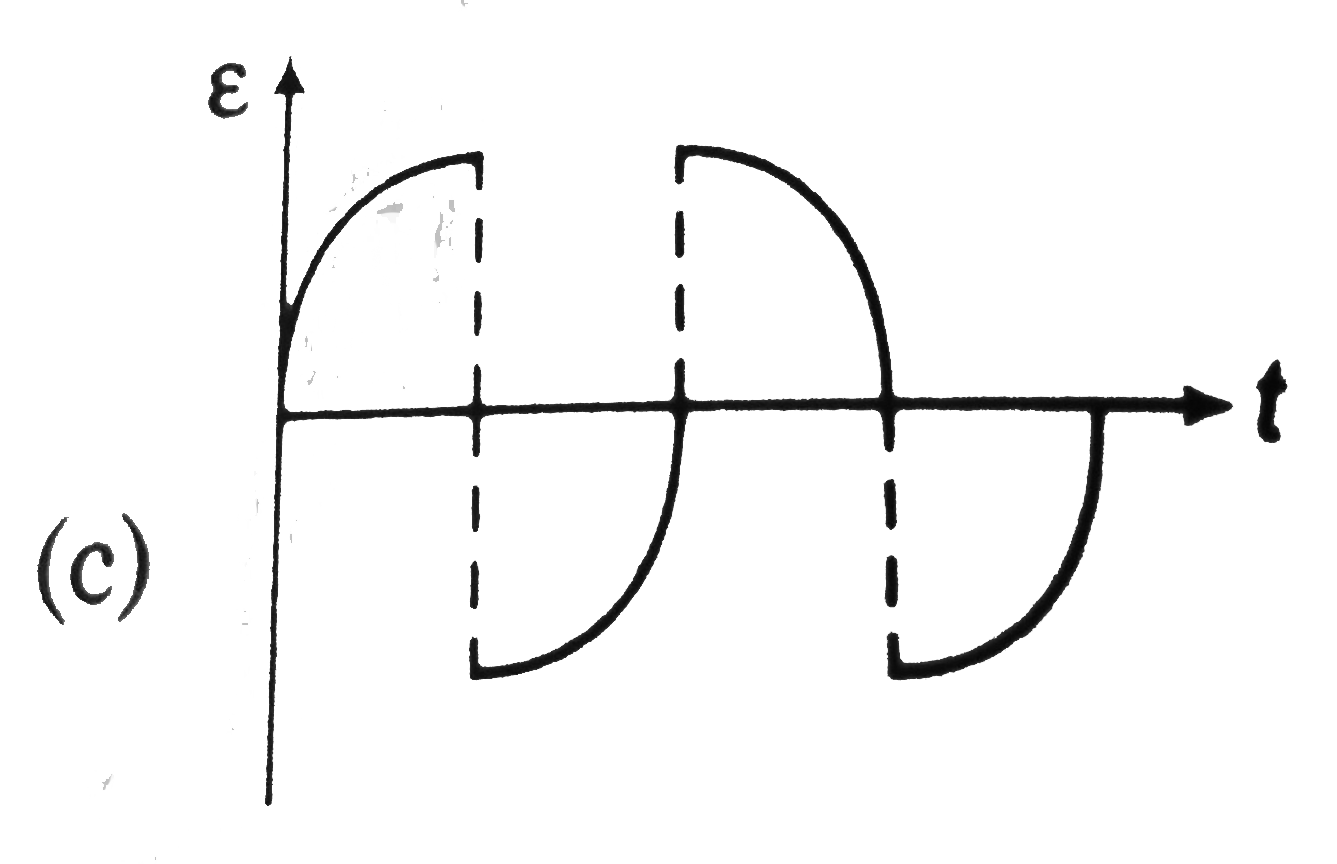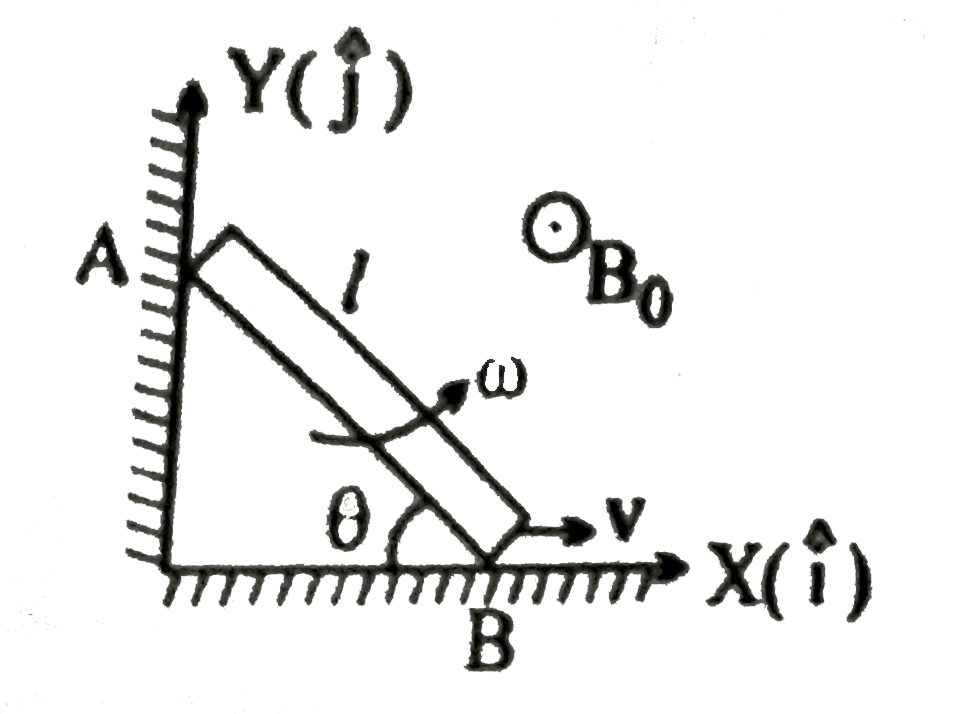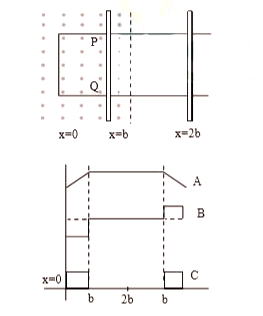A straight conductig rod PQ is executing SHM in xy-plane from x=−d to x=+d. Its mean position is x=0 and its length is along y-axis. There exists a uniform magnetic field B from x=−d to x=0 pointing inward normal to the paper andfrom x=0 to x=+d there exists another uniform magnetic field of same magnetic B but pointing outward normal to the plane of the paper. At the instant t=0, the rod is at x=0 and moving to the right. The induced emf (epsilon) acorss the rod PQ vs time (t) graph will be





The correct Answer is:B
At mean position, velocity is maximum. Hene, motional emf Bvl is also maximum. V oscillates simple harmonically. Hence, motional emf willl simple harmonically . Further, polarity of induced emf will keep on changing.
Related Playlists
- BOOK - DC PANDEYCHAPTER - ELECTROMAGNETIC INDUCTIONEXERCISE - Level 2 More Than One Correct10videos
ELECTROMAGNETIC INDUCTION
- BOOK - DC PANDEYCHAPTER - ELECTROMAGNETIC INDUCTIONEXERCISE - Level 2 Comprehension Based13videos
ELECTROMAGNETIC INDUCTION
- BOOK - DC PANDEYCHAPTER - ELECTROMAGNETIC INDUCTIONEXERCISE - Level 1 Subjective21videos
ELECTROMAGNETIC INDUCTION
- BOOK - DC PANDEYCHAPTER - CURRENT ELECTRICITYEXERCISE - Medical entrances gallery97videos
CURRENT ELECTRICITY
- BOOK - DC PANDEYCHAPTER - ELECTROMAGNETIC WAVESEXERCISE - Sec C22videos
ELECTROMAGNETIC WAVES
Similar Practice Problems
- Question 1 - Select One
The magnetic field due to a short magnet at a point in its axis at distance X cm from the middle of the magnet is
A100 GaussB400 GaussC50 GaussD200 Gauss - Question 1 - Select One
A conducting rod AB moves parallel to x-axis in a uniform magnetic field pointing perpendicular and into the plane of paper. The end A of the rod
 Agets positively chargedBgets negatively chargedCremains neutralDgets positively charged first and then negatively charged
Agets positively chargedBgets negatively chargedCremains neutralDgets positively charged first and then negatively charged - Question 1 - Select One
A conducting rod AB moves parallel to x-axis in the x-y plane. A uniform magnetic field B pointing normally out of the plane exists throughout the region. A force F acts perpendicular to the rod, so that the rod moves with uniform velocity v. The force F is given by (neglect resistance of all the wires)
 AvB2l2Re−t/RCBvB2l2RCvB2l2R(1−e−t/RC)DvB2l2R(1−e−2t/RC)
AvB2l2Re−t/RCBvB2l2RCvB2l2R(1−e−t/RC)DvB2l2R(1−e−2t/RC) - Question 1 - Select One
A uniform magnetic field exists in the plane of paper pointing from left to right as shown in figure. In the field, an electron and a proton move as shown. The electron and the proton experience:
 A(a) forces both pointing into the plane of paperB(b) forces both pointing out of the plane of paperC(c) forces poiting into the plane of paper and out of the plane of paper, respectively.D(d) forces pointing opposite and along the direction of the uniform magnetic field respectively
A(a) forces both pointing into the plane of paperB(b) forces both pointing out of the plane of paperC(c) forces poiting into the plane of paper and out of the plane of paper, respectively.D(d) forces pointing opposite and along the direction of the uniform magnetic field respectively - Question 1 - Select One
A long straight wire along the z-axis carries a current I in the negative z-direction. The magnetic vector field B at a point having coordinate (x,y) on the z=0 plane is:
Aμ0I(yˆi−xˆj)2π(x2+y2)Bμ0I(xˆi+yˆj)2π(x2+y2)Cμ0I(xˆj−yˆi)2π(x2+y2)Dμ0I(xˆi−yˆj)2π(x2+y2)
Similar Questions
Let there be a uniform electric field "E" existing along the positive X-direction.Assume electric potential to be zero at the origin.Potential at the point x=x0 is
View SolutionA thin conducting rod of length l=5m is moved such that its end B moves along the X-axis while end A moves along the Y-axis A uniform magnetic field B=6ˆk T exists
 View Solution
View SolutionThere exists a uniform magnetic field ¯¯¯B=B0t¯k in a region. A circular conducting loop of radius r and resistance R is placed with its plane in x-y plane. Determine the current through the loop and sense of the current.
View SolutionThe arm PQ of a rectangular conductor is moving from x = 0 to x = 2b outwards and then inwards from x = 2b to x = 0 as shown in the figure. A uniform magnetic field perpendicular to the plane is acting from x = 0 to x = b. Identify the graph showing the variation of different quantities with distance :
 View Solution
View SolutionConsider the following figure, a uniform magnetic field of 0.2 T is directed along the positive X-axis. The magnetic flux through top surface of the figure.
 View Solution
View Solution

